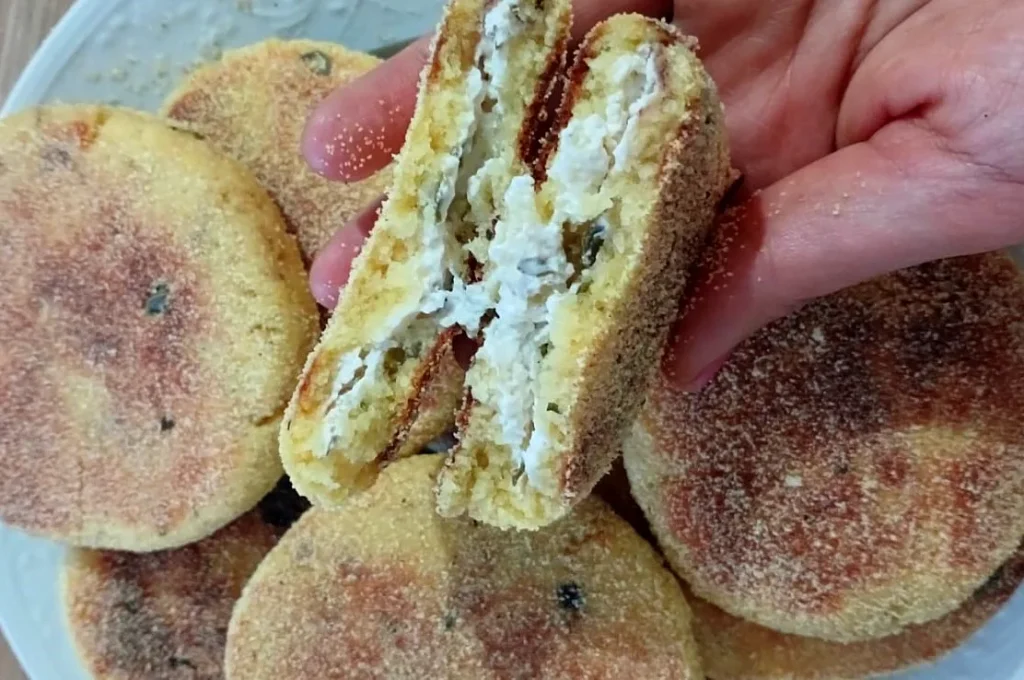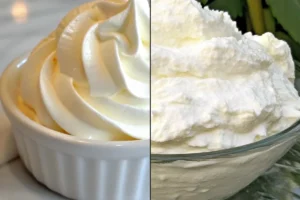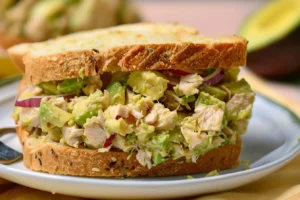Moroccan stuffed Harcha was one of the first dishes I learned to make in my grandmother’s kitchen. The aroma of warm semolina filled the air as she pressed the dough together, carefully sealing in a delicious mixture of cheese, olives, and thyme. Unlike the traditional plain Harcha, which we often enjoyed with honey and butter, this stuffed version felt extra special—crispy on the outside, soft on the inside, and bursting with flavor. Every bite reminded me of cozy family mornings, gathered around the table with Moroccan mint tea.
This Moroccan stuffed Harcha is perfect for any occasion, whether you need a quick breakfast, a light dinner, or a satisfying snack. Made with simple ingredients and cooked to golden perfection, it offers a delicious balance of textures and flavors. In this guide, we’ll take you through the step-by-step process, sharing expert tips to help you achieve the perfect Harcha every time.
What is Harcha?
Harcha is a traditional Moroccan semolina bread that is often compared to English muffins or cornbread in texture. Unlike regular bread, Harcha is pan-fried instead of baked, giving it a crispy golden crust while remaining soft inside.
Why Try Stuffed Moroccan Harcha?
While the classic version of Harcha is delicious on its own, stuffing it with cheese, olives, and thyme enhances the flavor, making it even more irresistible. The combination of creamy cheese, briny olives, and aromatic thyme adds depth, making this dish a savory delight perfect for any meal.
If you love experimenting with different textures in baking, you might also enjoy learning about how to keep toppings firm. Does Cool Whip Hold Up on a Cake?“
Ingredients for Moroccan Stuffed Harcha with Cheese, Olives & Thyme
Now that we’ve covered the basics, let’s dive into the ingredients you’ll need to make Moroccan stuffed Harcha. The right ingredients make all the difference, so choosing high-quality semolina, fresh cheese, and flavorful olives will elevate the dish.
Essential Ingredients for Harcha Dough
To create the perfect crispy yet soft Harcha, you’ll need:
- Fine Semolina (2 cups) – The key ingredient that gives Harcha its signature texture. Opt for fine semolina for a smooth dough.
- Milk or Water (½ cup) – Helps bind the dough. Milk adds a richer flavor, while water keeps it light.
- Melted Butter (¼ cup) – Enhances flavor and helps create a golden crust.
- Baking Powder (1 teaspoon) – Adds a slight fluffiness to the dough.
- Salt (½ teaspoon) – Balances the flavors.
- Olive Oil (2 tablespoons) – Keeps the dough soft and prevents dryness.
💡 Pro Tip: If you want a slightly softer Harcha, use a mix of milk and yogurt instead of just milk or water!
Delicious Stuffing: Cheese, Olives, and Thyme
What truly sets stuffed Moroccan Harcha apart is the savory filling. Here’s what you’ll need:
- Cheese (½ cup, grated) – You can use feta, ricotta, or cream cheese for a creamy texture. If you prefer a stronger taste, goat cheese works well.
- Black or Green Olives (¼ cup, chopped) – Adds a tangy, briny flavor that complements the cheese beautifully.
- Fresh Thyme (1 tablespoon, chopped) – Brings an aromatic, earthy touch to the filling. Dried thyme works too, but fresh thyme gives the best flavor.
- Black Pepper (¼ teaspoon) – A hint of spice to enhance the filling.
💡 Did you know? Thyme is commonly used in Moroccan cuisine not just for its taste but also for its digestive benefits.
Optional Ingredients for Extra Flavor
Want to customize your stuffed Harcha? Here are some tasty add-ins:
- Chopped sun-dried tomatoes – Adds a slight sweetness and depth.
- Caramelized onions – Provides a rich, savory balance.
- Chili flakes – If you love heat, a pinch of chili flakes will give it a spicy kick!
With these carefully chosen ingredients, your Moroccan stuffed Harcha will be flavorful, crispy on the outside, and deliciously cheesy inside.
Step-by-Step
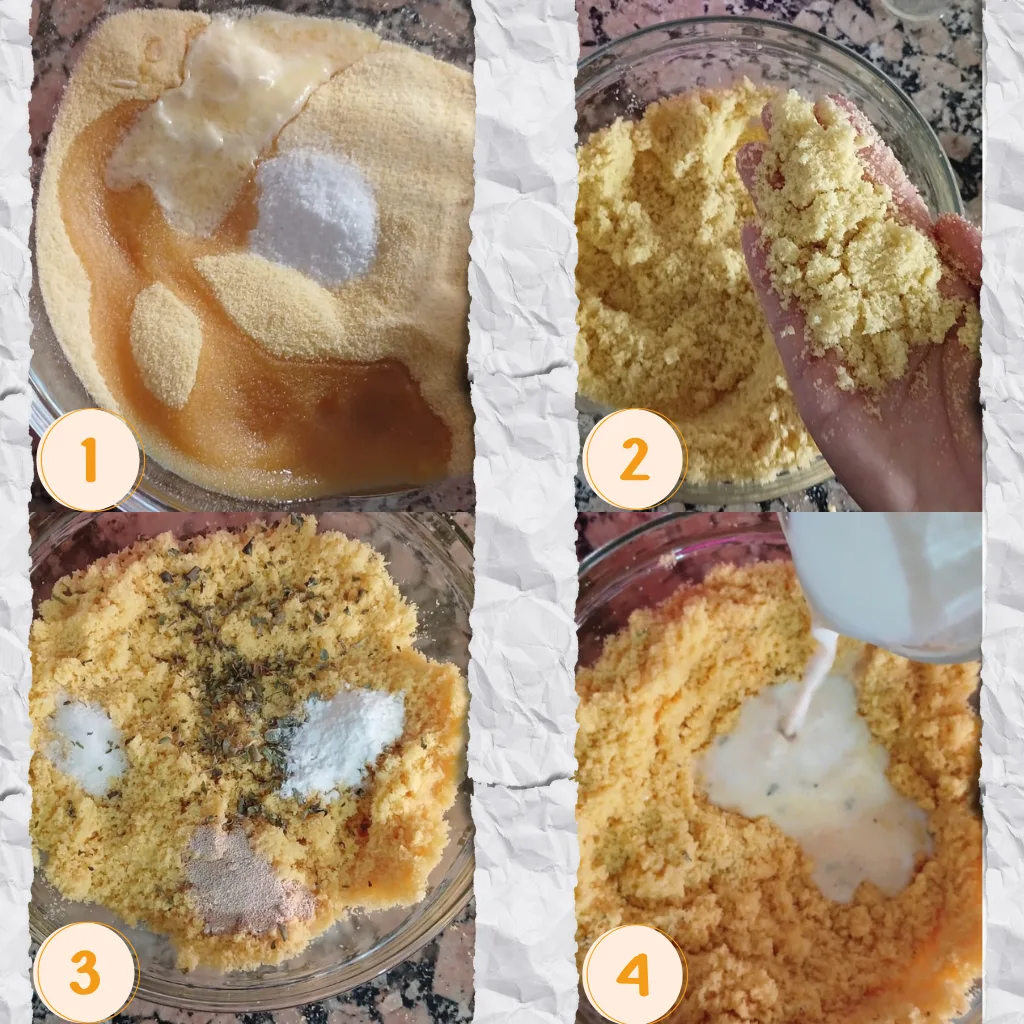
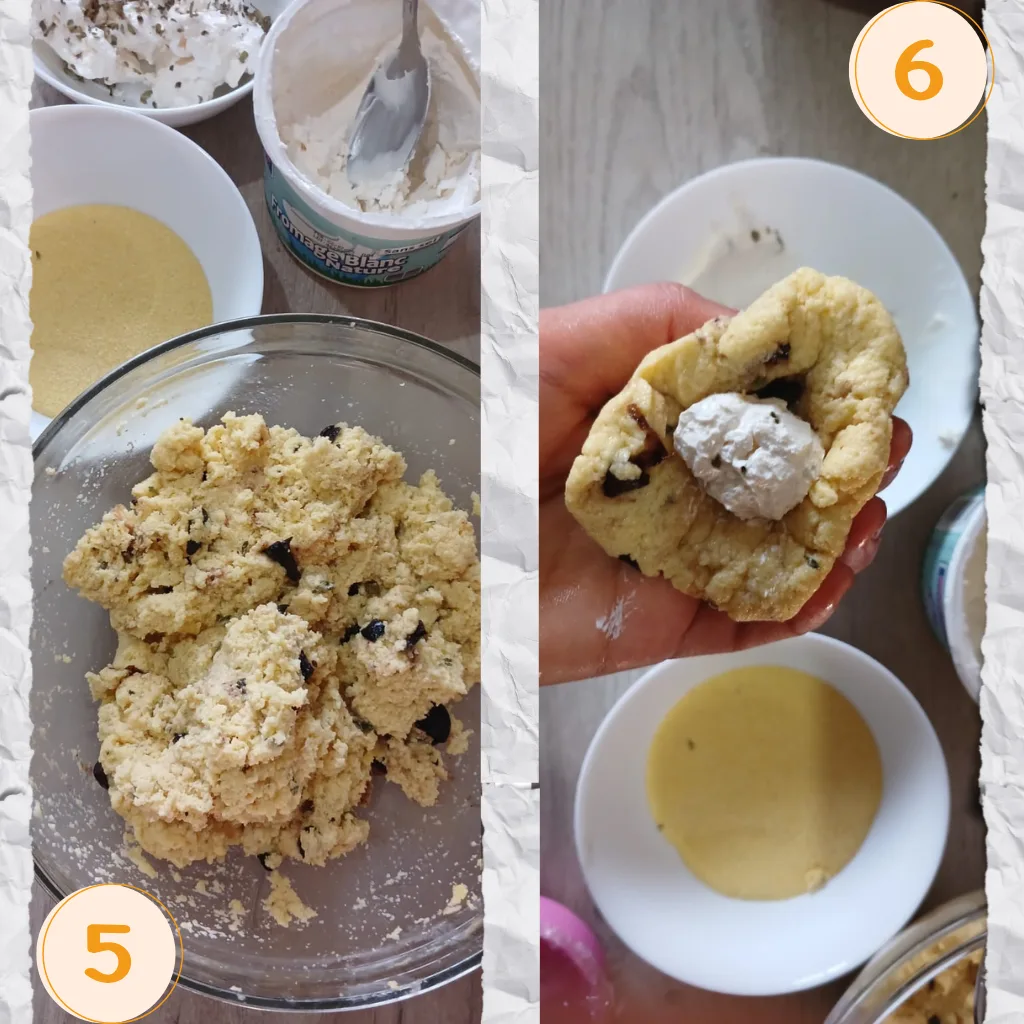

Now that we have all the ingredients ready, it’s time to start making our delicious stuffed Harcha. Follow these simple steps to ensure your Harcha turns out golden, crispy on the outside, and soft on the inside.
Step 1: Preparing the Dough – The Key to a Perfect Texture
A well-prepared dough is the foundation of a great Harcha. Follow these steps carefully:
- Mix the Dry Ingredients – In a large bowl, combine the fine semolina, baking powder, salt, and sugar (if using). Stir everything together to distribute the ingredients evenly.
- Incorporate the Butter – Pour the melted butter over the semolina mixture. Using your fingertips, gently rub the butter into the semolina until the mixture resembles wet sand. This step is crucial for achieving a tender texture.
- Add the Warm Milk Gradually – Slowly pour in the warm milk, mixing gently with a spoon or your hands. The dough should be soft but not sticky. If it feels too dry, add a little more milk, one tablespoon at a time.
- Let the Dough Rest – Cover the bowl with a clean towel and let the dough rest for 10-15 minutes. This allows the semolina to absorb the moisture and makes it easier to handle.
Step 2: Assembling & Stuffing the Harcha
Now comes the fun part—stuffing the Harcha with cheese, olives, and thyme!
- Divide the Dough – Once the dough has rested, divide it into equal-sized balls, about the size of a small orange.
- Flatten and Add the Filling – Take one dough ball and gently flatten it into a round disc, about ½ inch thick. Place a generous spoonful of cheese, chopped olives, and thyme in the center.
- Seal the Harcha – Carefully fold the edges over the filling, pinching the dough to seal it. Gently flatten it again into a thick disc, making sure the filling is completely enclosed.
- Dust with Semolina – Lightly coat both sides of the Harcha with fine semolina to create a crispy crust when cooking.
Step 3: Cooking Methods – Pan-Frying vs. Baking
There are two ways to cook Moroccan stuffed Harcha:
Pan-Frying (Traditional Method)
- Preheat a non-stick pan or griddle over medium-low heat.
- Place the stuffed Harcha onto the hot pan and cook for 4-5 minutes on each side, or until golden brown.
- Flip carefully using a spatula to avoid breaking the dough. Cook evenly on both sides until crispy and golden.
Baking (Healthier Alternative)
- Preheat the oven to 350°F (180°C).
- Arrange the stuffed Harcha on a baking sheet lined with parchment paper.
- Brush lightly with olive oil or melted butter for a golden finish.
- Bake for 20-25 minutes, flipping halfway through, until golden brown.
Tips for the Best Moroccan Stuffed Harcha
Making stuffed Moroccan Harcha is simple, but getting the perfect golden crust, soft texture, and balanced flavors requires a few expert tricks. Here are some key tips to ensure your Harcha turns out delicious every time.
1. Choosing the Right Semolina for the Dough
The type of semolina you use makes all the difference:
- Fine Semolina – Always use fine semolina for the best texture. Coarse semolina will make the Harcha too rough and dry.
- Fresh Semolina – Check the expiration date! Old semolina absorbs less moisture, making the dough difficult to work with.
2. Getting the Perfect Golden Crust
Achieving a crispy, golden crust while keeping the inside soft is key:
- Coat the Dough with Semolina – Before cooking, always lightly dust the stuffed Harcha with fine semolina. This helps create a crunchy, beautiful crust.
- Cook on Low to Medium Heat – If the pan is too hot, the outside will burn before the inside is cooked. Keep the heat at medium-low for even cooking.
- Don’t Flip Too Early – Let one side cook for at least 4-5 minutes before flipping. This prevents breaking and ensures a golden finish.
3. Alternative Fillings for Harcha
While cheese, olives, and thyme create a classic Moroccan flavor, you can experiment with different fillings:
| Alternative Filling | Flavor Profile |
|---|---|
| Feta & Spinach | A Mediterranean touch with a salty, creamy balance |
| Ground Meat & Onions | Perfect for a hearty, protein-packed meal |
| Honey & Ricotta | A sweet version for breakfast or dessert |
| Nutella & Almonds | A delicious treat for chocolate lovers |
| Tuna & Harissa | A spicy, tangy twist for seafood fans |
If you love bold flavors, try adding a pinch of cumin, paprika, or chili flakes to your stuffing for extra depth.
Just like baking cookies, getting the right texture in Harcha can be tricky. If you’ve ever wondered, Why Did My Cookies Come Out So Flat? Baking Fixes & Tips can help you troubleshoot similar dough-related issues.
How to Serve Moroccan Stuffed Harcha
Once your Moroccan stuffed Harcha is golden, crispy, and filled with delicious cheese, olives, and thyme, it’s time to serve it! But what’s the best way to enjoy this savory semolina treat? Let’s explore the top serving suggestions, side dishes, and the best times to enjoy Harcha.
1. Best Side Dishes & Accompaniments
Stuffed Harcha pairs well with many Moroccan and Mediterranean flavors. Here are some delicious sides to serve with it:
| Side Dish | Why It Works |
|---|---|
| Moroccan Mint Tea | A refreshing balance to the rich, cheesy filling. |
| Harira (Moroccan Soup) | A hearty, spiced soup that complements Harcha’s texture. |
| Olive Tapenade | Enhances the olive flavor in the stuffing. |
| Fresh Tomato & Cucumber Salad | Adds a light, fresh contrast to the buttery semolina. |
| Hummus or Baba Ganoush | Creamy dips for extra richness. |
| Honey or Fig Jam | A sweet contrast to the savory filling. |
If you love dipping, try serving your Harcha with a side of harissa-spiced yogurt sauce for a spicy, tangy kick!
2. Serving Harcha for Breakfast, Snack, or Dinner
One of the best things about stuffed Moroccan Harcha is its versatility. You can enjoy it at any time of the day!
- Breakfast – Serve it warm with Moroccan mint tea or coffee for a filling start to the day.
- Light Lunch or Snack – Pair it with a salad or soup for a balanced midday meal.
- Dinner – Enjoy it with roasted vegetables or grilled meat for a comforting evening meal.
For a traditional Moroccan experience, serve it on a decorative plate with a side of olives, cheese, and a drizzle of honey.
Nutritional Benefits of Semolina-Based Harcha
Many people wonder if Moroccan stuffed Harcha is a healthy choice. Since it’s made from semolina, cheese, and butter, it provides a rich source of energy, fiber, and essential nutrients. Let’s break down its nutritional profile, health benefits, and ways to make it even healthier.
1. Is Harcha Healthy? Breaking Down the Nutrition
Harcha is nutrient-dense, but like any dish, its healthiness depends on the ingredients and portion sizes. Here’s a general breakdown per serving (one medium-sized stuffed Harcha):
| Nutrient | Approximate Amount per Serving |
|---|---|
| Calories | 250-300 kcal |
| Carbohydrates | 30-35g |
| Protein | 6-8g |
| Fats | 10-15g |
| Fiber | 3-4g |
| Calcium | Moderate (from cheese) |
| Iron | Moderate (from semolina) |
- Semolina is a great source of complex carbohydrates, providing long-lasting energy without sudden sugar spikes.
- Cheese adds protein and calcium, which are essential for bone health and muscle repair.
- Olives provide healthy fats and antioxidants, beneficial for heart health.
However, because Harcha is pan-fried, it may be high in fats if too much butter or oil is used.
2. Healthier Alternatives & Modifications
If you want to make your stuffed Harcha even healthier, here are some simple swaps:
| Ingredient | Healthy Alternative | Why It Works |
|---|---|---|
| Butter | Olive oil or ghee | Reduces saturated fat, adds heart-healthy fats. |
| Regular Cheese | Low-fat cheese or feta | Cuts down on calories while keeping flavor. |
| Whole Milk | Almond or oat milk | Lowers fat content and makes it dairy-free. |
| White Semolina | Whole wheat semolina | Increases fiber for better digestion. |
| Pan-Frying | Baking | Uses less oil for a lower-calorie option. |
If you’re watching your calorie intake, try serving Harcha with fresh salads instead of high-fat dips.
Common Mistakes to Avoid When Making Harcha
Even though stuffed Moroccan Harcha is simple to prepare, small mistakes can affect its texture, flavor, and appearance. If your Harcha turns out too dry, too crumbly, or unevenly cooked, don’t worry! Here’s a guide to common mistakes and how to fix them.
1. Why Does Harcha Turn Out Dry or Crumbly?
One of the most frequent issues with Harcha is that it falls apart or feels too dry. Here’s why it happens and how to fix it:
| Problem | Possible Cause | Solution |
|---|---|---|
| Dough is too dry | Not enough liquid added | Gradually add more warm milk until dough is soft. |
| Crumbly texture | Butter wasn’t mixed properly | Rub butter evenly into semolina until it resembles wet sand. |
| Overcooking | Cooked on too high heat | Use medium-low heat and cook slowly for a soft interior. |
💡 Pro Tip: Always let the dough rest for at least 10-15 minutes before shaping. This allows the semolina to absorb the liquid and create a moist, cohesive dough.
2. Preventing a Soggy or Undercooked Texture
On the other hand, sometimes Harcha can turn out too soft, undercooked, or even soggy inside. Here’s how to avoid that:
| Problem | Possible Cause | Solution |
|---|---|---|
| Soggy inside | Dough too wet | Reduce liquid slightly or let it rest longer before cooking. |
| Undercooked center | Heat too high, cooking too fast | Lower the heat and cook for a longer time. |
| Not holding its shape | Dough is too soft | Chill the shaped dough in the fridge for 10 minutes before cooking. |
💡 Pro Tip: If your Harcha cooks too fast on the outside but stays raw inside, try covering the pan with a lid to allow gentle steaming while frying.
3. Mistakes to Avoid When Stuffing Harcha
Since we’re making stuffed Moroccan Harcha, the filling process is crucial. Here’s what to keep in mind:
- Don’t Overfill – Too much cheese or olives can cause the dough to break. Use just enough filling so the Harcha can be sealed properly.
- Seal the Edges Well – If the filling leaks out while cooking, it can burn and create a mess. Gently pinch and smooth the dough around the edges before cooking.
- Distribute Filling Evenly – Place the filling in the center, then spread it out slightly for even distribution.
💡 Pro Tip: If you’re having trouble sealing the Harcha, wet your fingertips slightly with water—it helps stick the dough together more easily.
FAQs About Moroccan Stuffed Harcha Recipe
1. What is Harcha food?
Harcha is a traditional Moroccan semolina bread, similar in texture to cornbread or English muffins. Unlike regular bread, it’s pan-fried instead of baked, giving it a crispy, golden crust while remaining soft inside. It can be served plain with butter and honey or stuffed with cheese, olives, and herbs for a savory twist.
2. How to eat Harcha?
Harcha is incredibly versatile and can be enjoyed in several ways:
- For Breakfast – Serve it warm with Moroccan mint tea, honey, butter, or jam.
- As a Snack – Pair it with fresh cheese, olive tapenade, or hummus.
- For Lunch or Dinner – Enjoy it stuffed with cheese, meats, or vegetables alongside a salad or soup.
💡 Pro Tip: For an extra crispy texture, reheat leftover Harcha in a dry pan for a couple of minutes before serving.
3. Are semolina biscuits healthy?
Yes! Semolina is a nutrient-rich grain that provides complex carbohydrates, fiber, and essential minerals like iron and magnesium. However, because Harcha is pan-fried, it may be high in fat if cooked with too much butter or oil.
To make a healthier version, try:
- Using whole wheat semolina for extra fiber.
- Cooking with olive oil instead of butter.
- Baking instead of pan-frying.
4. What are the ingredients in a Moroccan Harcha?
The classic Harcha dough is made with:
- Fine semolina
- Butter (or olive oil)
- Milk (or buttermilk)
- Baking powder
- Salt and sugar (optional)
For stuffed Moroccan Harcha, you can add cheese, olives, herbs, or even sweet fillings like dates and almonds.
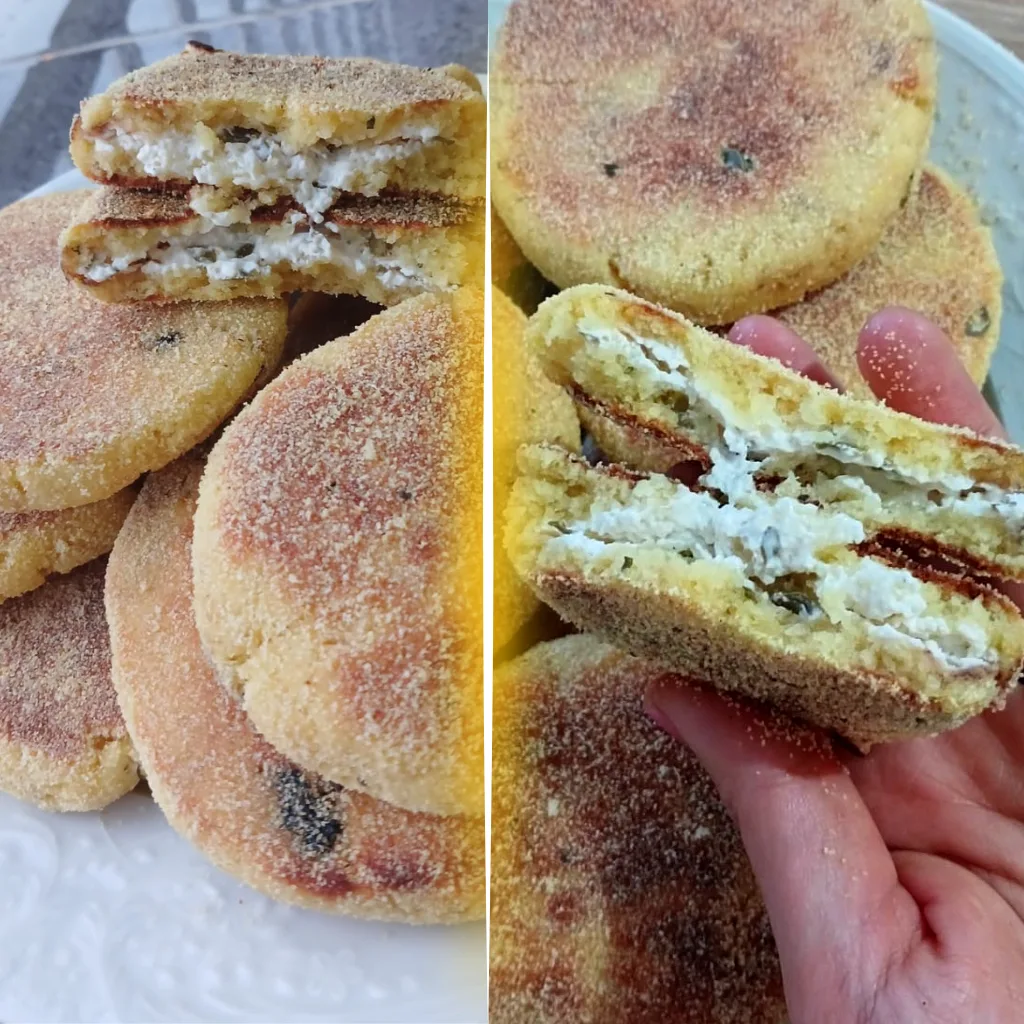
Conclusion
Moroccan stuffed Harcha is more than just a simple bread—it’s a delicious, versatile dish that brings together rich textures and bold flavors. Whether you enjoy it plain or stuffed with cheese, olives, and thyme, Harcha makes a perfect breakfast, snack, or light meal.
This recipe is not only easy to make, but it also allows you to experiment with different fillings, from sweet variations like honey and nuts to savory combinations like feta and spinach. Plus, by making a few healthy swaps, you can enjoy a lighter, more nutritious version without sacrificing taste.
So why not try making Moroccan stuffed Harcha today? Pair it with mint tea, hummus, or a fresh salad, and experience a true taste of Moroccan cuisine from your own kitchen!
Looking for More Moroccan Recipes?
If you loved this recipe, check out these other delicious Moroccan dishes:
- Moroccan Baghrir (Honeycomb Pancakes) – A light and spongy breakfast treat.
- Khobz (Traditional Moroccan Bread) – A staple in Moroccan meals.
- Msemen (Layered Moroccan Flatbread) – Perfect for dipping in honey or serving with savory fillings.
if you enjoy sweet treats as well, you may be interested in knowing, Do Boston Cream Cupcakes Need to Be Refrigerated? before storing your baked goods.
Happy cooking!
